 |
 |
| 虎渓山永保寺とオリベストリート Kokeizan, Eihoji Temple and Oribe Street [Photos taken on April 27, 2003] |
| 2003年4月27日、ゴールデンウィークは近場でゆっくり楽しもうと岐阜県多治見市の 本町オリベストリートと虎渓山永保寺へ行きました。 岐阜県内で提唱されている古田織部の精神「オリベイズム(斬新で自由な発想)」を 「まちづくり」に取り入れ、多治見市で培われてきた暮らしや文化を活かす為に 「本町オリベストリート」ができました。 この付近は1920年代迄(昭和初期)は 美濃地方の陶磁器の問屋街でした。 本町オリベストリート沿いの「たじみ創造館」内を見学し、1階の「多治見市PR センター」でパンフレット「本町オリベストリートーはなやぎのまち」をもらい、そこに 紹介してあって「優」のマークが付いていたフランス料理のレストラン「櫻」で昼の ランチを食べましたが、「優」のマークの付いたお店は全て何らかのサービスがあり 小生はこのレストランでワインをグラス一杯サービスしてもらいました。 (是非、 パンフレットを活用して下さい) この付近を歩いて気付いた事は、「瀬戸市と地名等で同じものがある。 例えば<記念橋>、<窯町>、<宮前>、<末広町>、<元町>」。又、瀬戸市では愛知県で 最も古い木造の交番である大正時代に建築された、大正ロマンの香りがする 織部瓦の蔵所交番を老朽化に伴い、移転復元予定ですが、多治見市の本町 オリベストリートには出来たての感じの黒塗り木製壁の本町交番がありました。 昼食後、虎渓山に向かい、虎渓公園となっている山上の駐車場に駐車して当たりを 見ると藤棚は紫の藤が咲き誇り、園内はカップルや家族連れで賑わっていました。 小生は、そこから木々に囲まれた石段を降りて永保寺へ行きました。 虎渓山永保寺は臨済宗の古刹であり、 観音堂、開山堂が国宝に、庭園が名勝 に指定されている。以下の写真及び説明をご覧下さい。 I went to the Honcho Oribe Street and the Kokeizan Eihoji Temple of Tajimi City, Gifu Pref. to enjoy myself slowly in vicinity at Golden Week on April 27, 2003. In order to make public the life and culture which have been cultivated in Tajimi City and to revitalize Tajimi, the city has adopted Oribe Furuta's soul "Oribeism (new and free way of thinking)" advocated in Gifu Prefecture and made "Honcho Street". The wholesaler of ceramics in East Mino district (Tajimi, Toki, Ena, Nakatugawa and Kasahara) gathered around the street till the 1920s. (early in Showa era). After looking at several shops inside of "Tajimi Creation Hall" along the Honcho Street, I got the pamphlet "Honcho Oribe Street Hanayagi-No-Machi"i at "Tajimi City PR center" of the first floor. I ate the launch of daytime at the restaurant "Sakura" of the French cuisine to which the mark of "A" was attached to the pamphlet. The store where the mark of "A" was attached offers a certain service. I was offered a glass of wine free of charge here. (By all means, please utilize a pamphlet.) Walking along this neighborhood, I have noticed the following: There is the same thing in the name of a place. For example, < Kinenbashi>, < kamamachi>, < Miyamae >, < Suehiro-cho>, < Motomachi >. Since the wooden police box at Kurasho-cho in Seto City was superannuated, the city is planning to transfer it and restore. This is the oldest wooden police box built in Aichi Prefecture in Taisho Era, and the roofing tile was made by pottery fired with green Oribe glazing agent and there is the scent of the Taisho romance in it. While, there is a police box of the black painting wooden wall which seems to be built recently in Honcho Oribe Street of Tajimi. After having lunch, I went to Kokeizan mountain (about 200 m heigh). In the top of the mountain, the parking lot and Kokei Park are layouted. To the wisteria trellis on the park, purple wisteria was in all glory. The park was crowded with the couple or the family companion. From there, I passed along the stone steps which were surrounded by trees and went to Eihouji temple (about 5 minutes). Eihouji is the historic old temple of Rinzai sect of Zen Buddhism. Kannnon-dou (a building which worships Kanzeon-Buddhist saint) and Kaisandou ( a building which enshrines the statue or image of the founder of this sect) are designated a national treasure, and the garden is designated scenic spot. Please see the following photos and notes. |
| 橋の東側 East of a bridge |
橋の西側 West of a bridge |
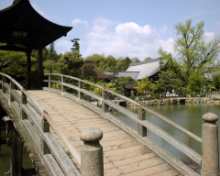 |
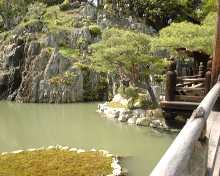 |
| 銀杏の木(注1) Ginkgo (Note 1) |
寺の一部鳥瞰図(注2) Bird's eye view of part of temple (Note 2) |
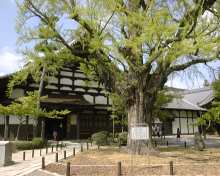 |
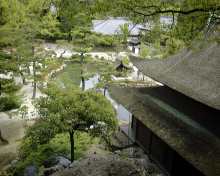 |
| 寺の東に隣接すし南北に流れる川 River adjoining the east of the temple and flowing north and south |
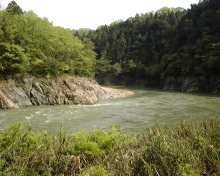 |
| (注) 1 銀杏の木 (立て看板の説明から抜粋) 樹高25.3m、目通り4.33m、枝張り20.5mの銀杏。永保寺の開山である 仏徳禅師(1332年没)お手植えの木として大切に保護された。この言い伝え が正しければ、樹齢は約670年になる。 1 Ginkgo tree (extracted from the explanation of a standing signboard) Height 25,3m Diameter 4.33m Spreading length of a branch 20.5m This tree has been taken care of carefully as a tree Buttoku Zen preist (died in 1332) planted. 2 永保寺観音堂 正和3年(1314)夢想国師がこれを建て水月場と命名した。鎌倉期の代表的 な唐様を主とした建築で和様の手法が加えられ一重もこし付入母屋造桧皮葺 の遺構である。庭園もまた夢想国師の作。自然の岩山を立石とし心字池をつくる。 禅林風庭園の典型である。昭和27年3月国宝に指定される。 心字池: 日本式庭園で「心」の字をかたどって造られた池 2 Reverend Priest, Musoukokushi built this in 1314 (Seiwa 3), and it was named "Suigetujyou" (leterally means water-and-moon place.). The technique of a Japanese mode is added to the construction mainly concerned with the typical Chinese mode of the Kamakura era, and they are the ruins of Irimoya Style roof which is covered with the bark of Japanese cypress. The garden was also made by the priest. "Shinji" pond was made with a natural rocky mountain being supposed a standing stone. This is typical Zenrin style garden. This building was designated a national treasure in March, 1952. Shinji pond: The pond which modeled the character of the "heart" and was built in the Japanese-style garden |